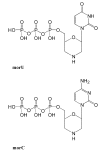Exploiting the nucleotide substrate specificity of repair DNA polymerases to develop novel anticancer agents
- PMID: 21926946
- PMCID: PMC6264456
- DOI: 10.3390/molecules16097994
Exploiting the nucleotide substrate specificity of repair DNA polymerases to develop novel anticancer agents
Abstract
The genome is constantly exposed to mutations that can originate during replication or as a result of the action of both endogenous and/or exogenous damaging agents [such as reactive oxygen species (ROS), UV light, genotoxic environmental compounds, etc.]. Cells have developed a set of specialized mechanisms to counteract this mutational burden. Many cancer cells have defects in one or more DNA repair pathways, hence they rely on a narrower set of specialized DNA repair mechanisms than normal cells. Inhibiting one of these pathways in the context of an already DNA repair-deficient genetic background, will be more toxic to cancer cells than to normal cells, a concept recently exploited in cancer chemotherapy by the synthetic lethality approach. Essential to all DNA repair pathways are the DNA pols. Thus, these enzymes are being regarded as attractive targets for the development of specific inhibitors of DNA repair in cancer cells. In this review we examine the current state-of-the-art in the development of nucleotide analogs as inhibitors of repair DNA polymerases.
Conflict of interest statement
The authors declare no conflict of interest.
Figures





References
Publication types
MeSH terms
Substances
LinkOut - more resources
Full Text Sources

